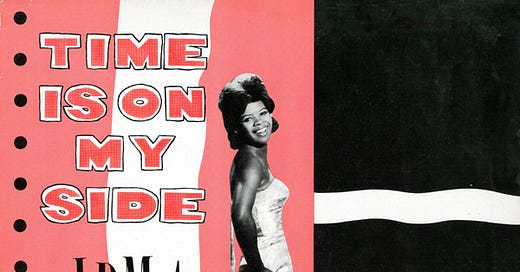IRMA THOMAS: TIME IS ON HER SIDE
CELEBRATING THE SOUL QUEEN OF NEW ORLEANS & A SONG SHE SHARES
The magnificent Irma LP that started my love affair with her back in the 80s.
In New Orleans last Friday Irma Thomas headlined the Blues & BBQ Festival. I wish I could have been there but, needless to say, I was stuck at home in damp South London. This noted, several pals did have the good fortune to be in the Crescent City and they all reported rapturously on Irma’s performance. Which isn’t surprising – I’ve seen Thomas perform at least four times (twice in London and two or three - or maybe four - times in New Orleans) over the past 30 years and she is always fabulous.
Actually, the first time I saw Irma remains quite possibly the greatest gig I’ve ever been to: it was at The Astoria, London, a brilliant venue long ago demolished for the Elizabeth Line’s Tottenham Court Road location, and she shared the bill with Earl King and Bobby ‘Blue’ Bland.
Earl came on first, wearing a bright pink suit, and he played the eloquent blues-flavoured R&B he was renowned for. That said, I don’t think he played Come On, his tune that Hendrix covered on Electric Ladyland. Bobby closed the night accompanied by his big US band – lots of horns – and sang with seductive smoothness: the Sinatra of the Blues? Indeed.
But it was Irma, sandwiched between these two major male talents, who damn near tore the roof off the Astoria! I’ve seen some fabulous singers in my time but Irma, at the Astoria, sang with a ferocity and soulfulness that shook me. Here was a singer, some 30+ years into a career that had never delivered the levels of fame and fortune she might originally have expected, who remained absolutely committed to her artistry. Soul singers can get jaded, tiring of the emotional force needed to convey a song to the listeners, but not Irma. She, I would later learn, stood by the old showbiz maxim of “the audience has paid to see me so I have to put on a good show.” Boy, did she ever!
Here’s a treat: Irma and Allen Toussaint (his final NO performance) and the Funky Meters share the stage and a selection of R&B gems they recorded way back when.
I knew, prior to the concert, that Thomas had recorded a great run of R&B 45s in the 1960s – I owned Time Is On My Side, a superb collection the UK’s Kent Records issued in the 1980s – but I wasn’t prepared for just how intense Irma was as a performer. She sang as the great gospel singers do, embracing each song’s emotional core and delivering a full-throated attack, seemingly living out the pain and fury. And what a rich voice, one that could move from a whisper-like caress to a gentle blues-flecked moan to roaring gospel diva.
Reports from Blues & BBQ Festival suggest Irma, now 83, still has the voice and commitment that originally wowed me. Time, then, is truly on her side – as she sang on a 45 B-side that’s gone on to be, arguably, her most famous tune.
In tribute to Irma I’ve decided, for this Yak post, to look at Time Is On My Side. Its now something of a standard but, originally, was considered a slight piece of work by its creator. Irma then turned it into something a soul standard and, while she never enjoyed the success of Aretha or Tina or Gladys (all of whom were her contemporaries), Thomas has proven she is just as iconic as the aforementioned stars. If you ever get the opportunity to see Irma Thomas sing then grab it – she’s the last of the best, a singer with both a great catalogue of songs and one who gives her all.
Who “owns” a song can be a matter of great debate when it involves different artists singing the same song. Otis Redding, on hearing Aretha Franklin’s version of his song Respect, told audiences approvingly “a friend of mine, this girl, she just took this song!" While Richard Rodgers, on hearing Janis Joplin’s version of Little Girl Blue, was horrified and commented that he couldn’t imagine anyone enjoying listening to her version. A song that remains contested is Time Is On My Side, the division here revealing tensions involving race, gender and nationality.
Not that any of this was foreseen in 1963 when 33 year old Jerry Ragovoy, a Philadelphia native making waves as both songwriter and arranger, fielded a request for a “commercial” song for popular Danish American jazz trombonist Kai Winding. Its hard to imagine now but, back then, jazz musicians were still capable of having hit singles – not just Louis Armstrong, there were numerous crossovers, tunes that often proved very popular in clubs so ended up with radio play – and Winding, who didn’t sing, was one of these pop jazz guys.




